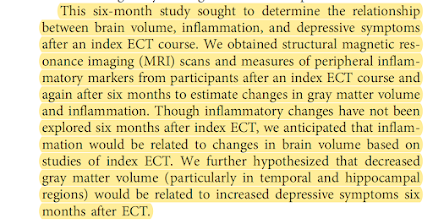Brain Plasticity and Inflammation are Independently Related to Changes in Depression Six Months After ECT: Study From UCLA
Out on PubMed, from investigators at UCLA, is this study:
Structural brain plasticity and inflammation are independently related to changes in depressive symptoms six months after an index ECT course.
Psychol Med. 2023 Jan 5:1-9. doi: 10.1017/S0033291722003555. Online ahead of print.PMID: 36600668

Background: Electroconvulsive therapy (ECT) is effective for treatment-resistant depression and leads to short-term structural brain changes and decreases in the inflammatory response. However, little is known about how brain structure and inflammation relate to the heterogeneity of treatment response in the months following an index ECT course.
Methods: A naturalistic six-month study following an index ECT course included 20 subjects with treatment-resistant depression. Upon conclusion of the index ECT course and again after six months, structural magnetic resonance imaging scans and peripheral inflammation measures [interleukin-6 (IL-6), IL-8, tumor necrosis factor (TNF-α), and C-reactive protein] were obtained. Voxel-based morphometry processed with the CAT-12 Toolbox was used to estimate changes in gray matter volume.
Results: Between the end of the index ECT course and the end of follow-up, we found four clusters of significant decreases in gray matter volume (p < 0.01, FWE) and no regions of increased volume. Decreased HAM-D scores were significantly related only to reduced IL-8 level. Decreased volume in one cluster, which included the right insula and Brodmann's Area 22, was related to increased HAM-D scores over six months. IL-8 levels did not mediate or moderate the relationship between volumetric change and depression.
Conclusions: Six months after an index ECT course, multiple regions of decreased gray matter volume were observed in a naturalistic setting. The independent relations between brain volume and inflammation to depressive symptoms suggest novel explanations of the heterogeneity of longer-term ECT treatment response.
Keywords: Depression; ECT; MRI; imaging; inflammation; neuroimaging.
The article is here.
And from the text:


This is a very interesting study that takes a look at brain structure and inflammatory markers 6 months after an index course of ECT. I would consider this the beginning of the second phase of research into brain structural changes with ECT; it is about longer term effects and correlations with inflammatory markers. The specific findings may or may not hold up to replication, but the door is opened to many more exciting lines of research to uncover the mechanism of action of ECT, as well as the underlying etiopathology of major psychiatric illnesses.
Kudos to the UCLA team for this innovative work.






Comments
Post a Comment